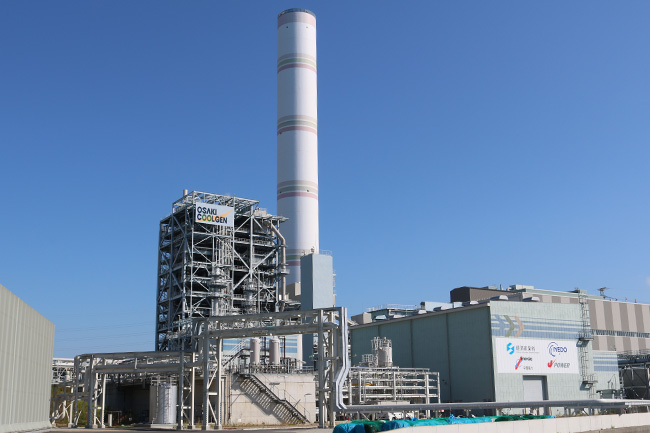Project Background
Situation of Energy in Japan
With limited resources of an energy self-sufficiency ratio of about 10%, Japan is required to combine and balance various energy sources.
Coal-fired power has high provision stability and outstanding economic feasibility, and is essential to achieve the "3E+S"* energy mix in the energy basic policy of Japan.
*Basic concept of Japan’s energy policy, consisting of Energy security, Economic efficiency, Environment, and Safety.
Japan's energy self-sufficiency ratio is about 10%
With little reserves of energy resources, Japan whose self-sufficient ratio in energy resources is about 10% has to rely on other countries for the energy resources it needs.
Comparison of primary Energy self-sufficiency ratio of major countries(2017)
Source:METI ”JAPAN‘S ENERGY2018”
Forecast for Japan's energy mix
Especially, fossil fuels account for the majority of Japan’s energy sources, according to the government's energy supply and demand forecast created assuming participation in the Paris Agreement, coal-fired power is expected to cover 26% in 2030.
Composition of electric power source in 2030.Japan
Source:METI Long-term energy supply-demand outlook(2015.7)
Coal-fired power has outstanding provision stability and economic feasibility
Compared to oil and natural gas, there are more extensive reserves of coal. They are spread broadly throughout the world, primarily in politically stable nations, which are advantages to stable supply. Furthermore, it is a resource that is less expensive than other fossil fuels and experiences less price fluctuations.
①Recoverable reserves and years
Source:BP Statistical Review of World Energy 2019
②Regional distribution of resource reserves
Source:BP Statistical Review of World Energy 2019
③Historical trend of fuel price
Source:Trade statistics of japan
Coal will support power in the future
Coal has outstanding "energy security" and "economic efficiency", and supports Japan's power demand.
Situation of Energy throughout the World
Power demand and power generation structure vary by country
Currently, approximately 40% of elctricity generated in the world accounts for coal-fired, making it the largest rate. It covers at least approximately 60% of power in the countries which consume huge amount of electricity such as India,China and so on.
Renewable energy and natural gas-fired power are expected to increase globally, but while there are movements towards reducing the use of coal in developed nations, it is predicted that the demand for coal-fired power will increase primarily in developing countries in Asia and elsewhere.
Power generation amounts by source in major countries
Source:IEA statistics(Electricity and Heat for 2016)
Power generation capacity increase of coal and gas in major regions
(2017-2040)[GW]
Source:IEA World Energy Outlook 2018 (New policy scenario)
Toward a Decarbonized Society for the Future
It is predicted that the power generated globally will increase as we move toward 2040 and the amount of fossil fuel consumed is expected to go up together with renewable energy.
We are seeing highly dependance on fossil fuels as energy sources such as coal and natural gas.
Especially, coal power generation emits more CO2 than natural gas do per kWh basis.
Therefore, to achieve reduction in amount of CO2 emitted from coal fired power plants in tandem with using coal as one of the most important and reliable natural resources is an urgent issue in the view point of energy stability and security.
Forecasts of Power Generation in the World
Forecasts of CO2 Emission in the World
Source:IEA World Energy Outlook 2018(New policy scenario)
New Role for Thermal Power
Role of thermal energy compared to renewable energy
Renewable energy does not emit CO2 during power generation, and therefore its installation is expected to be accelerated as part of countermeasures for global warming. On the other hand, renewable energy such as solar power and wind power face an issue in that the generated power fluctuates heavily depending on the weather.
Power supply and demand should be maintained equally for stability of the grid. If demand or supply overweighs, the grid would become unstable,and in the worst case scenario it could lead to black out of the grid.
In other words, role for adjusting capability is indispensable and nowadays thermal power shoulders the burden.
In that situation, thermal power can serve more important role of stabilizing the grid, as more renewables are being installed.
Illustration of power demand and generated power
The figure was created based on the "Illustration of power demand and generated power" in the link above.
Japanese Clean Coal Technology: Changing the World
Japan, a resource-importing country, is aiming for achieving an energy mix which makes use of many types of power such as thermal power, nuclear power, Hydro power, and so on in a well-balanced manner.
Of all resources, coal, whose calorific value is low and reserve is ample, needs to be made use as one of main resources.
On the contrary, coal has an aspect to emit more CO2 than other fossil fuels do.

Therefore to make the most use of coal as one of the main resources, the establishment of "Clean coal technology" which enables coal fired power plants to reduce their emissions of CO2 is needed as soon as possible.
Osaki CoolGen is a company which is conducting demonstration project aiming at achieving the establishment of IGFC with CO2 Capture which is one of the ultimate high-efficiency technologies and CO2 capture technologies.
On the other hand, there is an urgent need to develop clean coal technology to enhance the power generation efficiency of coal-fired thermal power and to significantly reduce carbon dioxide emissions in order to combat global warming. Osaki CoolGen Project is a demonstration project aiming to achieve innovative low-carbon coal-fired thermal power generation that combines the ultimate high-efficiency power generation technology of integrated coal gasification fuel cell combined cycle (IGFC) and CO2 capture technology.
See here for details about the Osaki CoolGen Project's "coal gasification technology!"